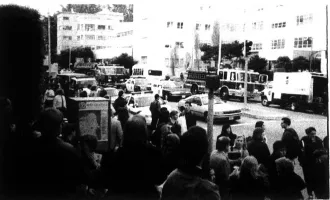PT Students Inspire Teens to Get Moving
If you take the UCSF shuttle to Mission Bay on a Thursday afternoon, you may find yourself outnumbered by animated physical therapy students. While they may be dressed in the exercise pants and tennis shoes often associated with physical therapy, their goal is of a more holistic nature: to inspire San Francisco teens to live a healthier lifestyle.
As part of the quarter-long program TeenFit, eight first-year physical therapy students work one on one with adolescents at the Mission Bay gym. For 90 minutes a week, the PT students challenge their young clients with dynamic activities that are both engaging and productive.
“It’s a space where teens can be active, have a lot of fun and be around really great role models,” said first-year PT student Genevieve Feeley. “It’s more than just exercise.”
Organized by third-year PT students, TeenFit offers teens referred by the UCSF WatchClinic exposure to physical fitness, mentorship with UCSF students and education on everyday health strategies.
A typical session commences with checking vital signs and a warm-up period of stretches and light exercises. The sessions are as diverse as the teenagers themselves, some focusing on nutrition and others incorporating kickball and boxing.
“I usually have a basic idea of what I want to do, and then I think of a fun way to do it that’s not just lifting weights,” said first-year student Daniel Fong, explaining how he structures sessions with his buddy.
The emphasis is on having fun. “A lot of times, I throw new stuff out there for my teen,” added Feeley. “We try a lot of activities and see what works for them. Motivation is different for teens.”
The teenagers’ goals range from weight loss, gaining confidence and making a sports team to improving in cheerleading and learning to jump higher. The PT students are “used to listening to patient cases in lectures or athletes before coming to UCSF,” confides student Joel Kinney, “so it’s really important to find common ground with the teens.”
Although they only get a few hours a week with the teenagers, the PT students are eager to problem- solve and synthesize their didactic experience with real life. “Working with the teens takes you back to that place of what it’s like to learn something for the first time,” said Feeley, who considers her experience with TeenFit as illuminating as her time in class.
The PT students face the same time constraints as other health professional students. Nonetheless, the constant flurry of exams and 30-plus hours of class time per week are not enough to deter them from participating. All PT students are appreciative of their experience.
“Anybody who has access to these young people should be a role model and have the mentality of telling our patients to be healthy,” said Kinney.


